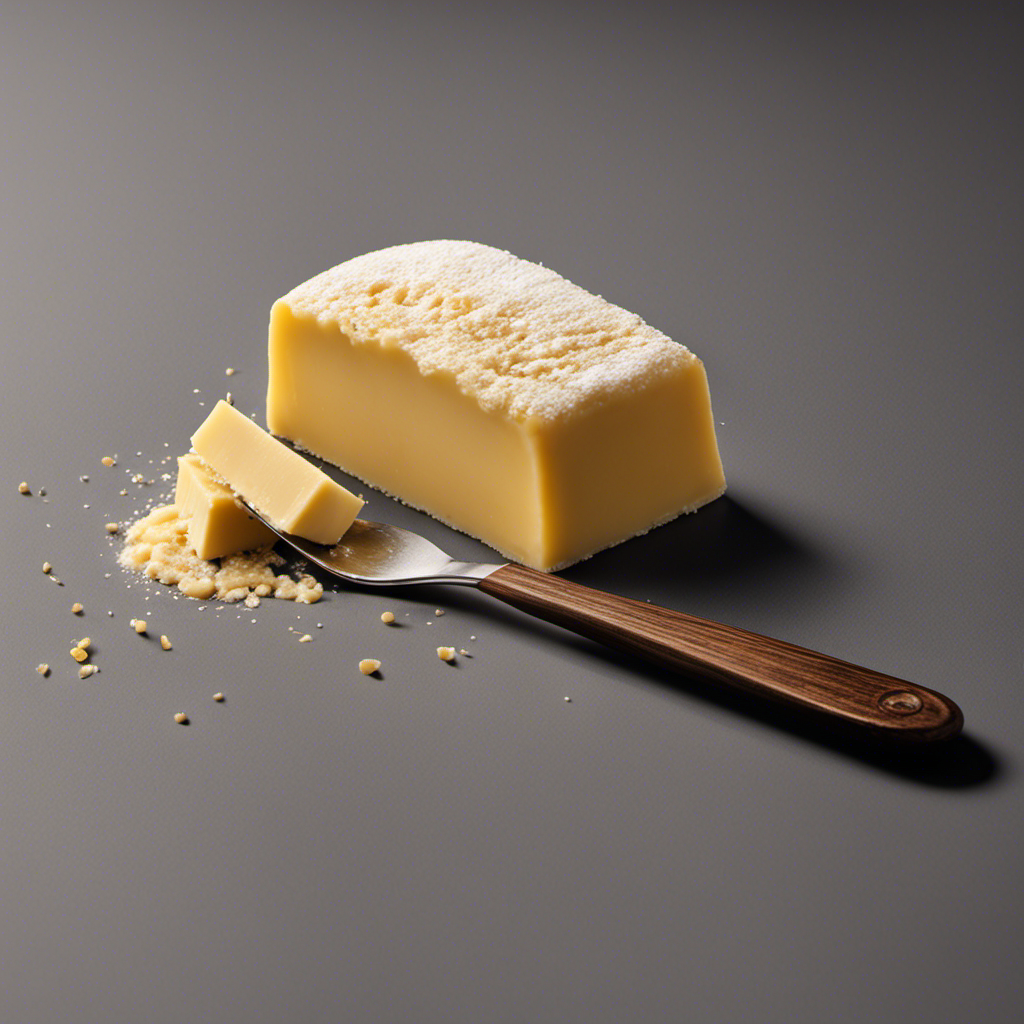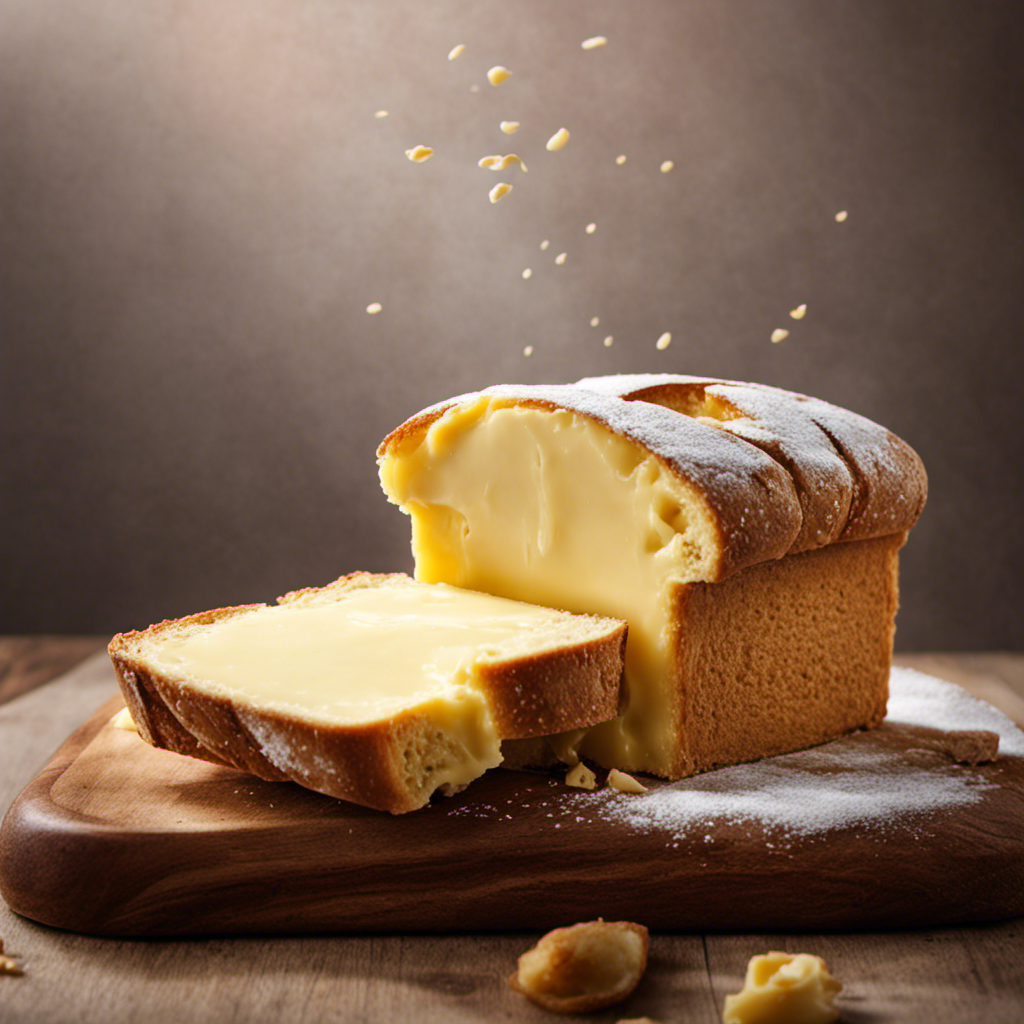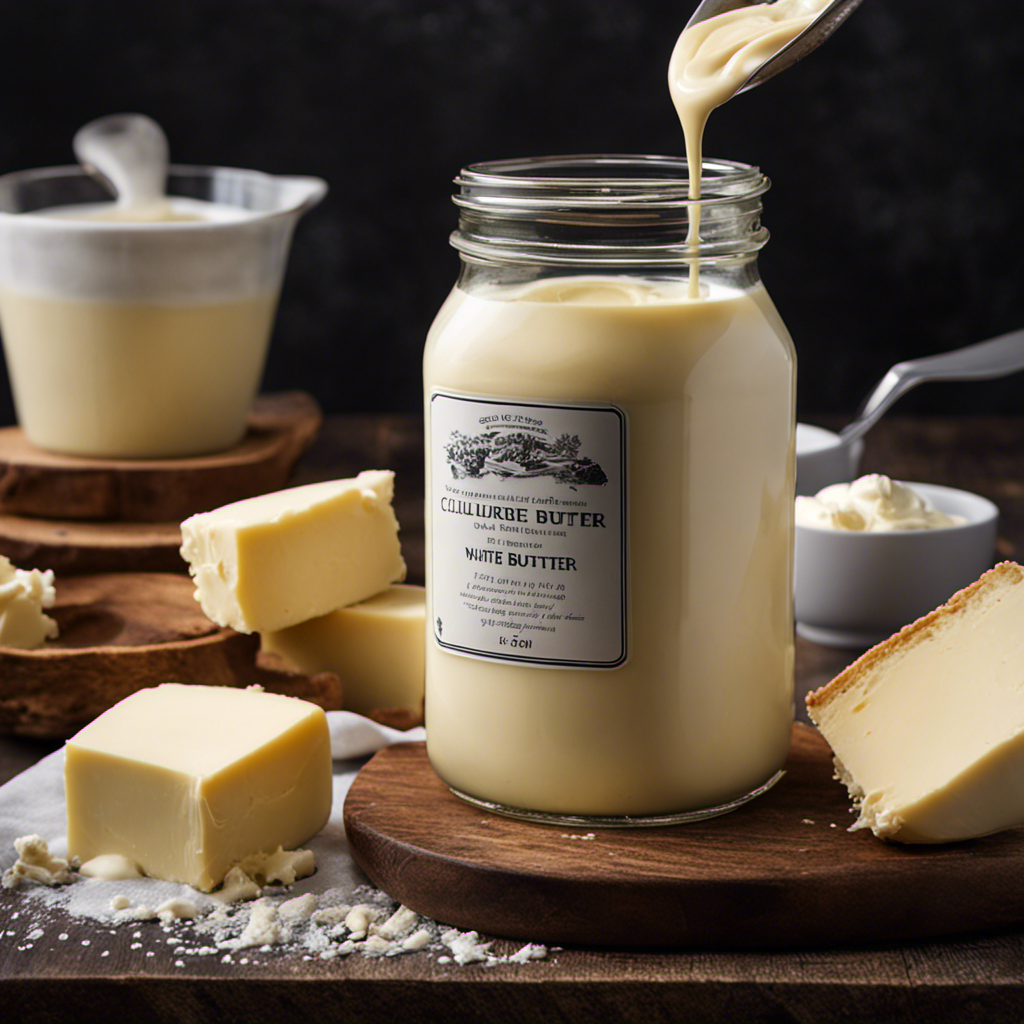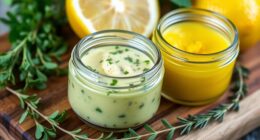I have always been curious about the amount of salt in one stick of butter. This question always comes to mind whenever I grab that recognizable yellow packaging at the grocery store.
In this article, we will delve into the role of salt in butter, explore the composition and salt content of different brands, and discuss the health implications of consuming salted butter.
So let’s dive in and uncover the salty truth about our beloved kitchen staple.
Key Takeaways
- Salt is added to butter for flavor and preservation.
- The amount of salt in salted butter is about 1/4 teaspoon (1.23 grams) per stick.
- Salted butter provides roughly 8% of the recommended daily intake of sodium.
- The choice between salted and unsalted butter depends on personal preference and dietary needs.
The Role of Salt in Butter
You’ll be surprised by the amount of salt in one stick of butter.
Many people wonder why salt is added to butter in the first place. The role of salt in butter is not just for flavor, but also for preservation. Salt acts as a natural preservative by inhibiting the growth of bacteria and other microorganisms that can spoil the butter.
It also enhances the taste of butter, making it more savory and delicious. In addition to preservation and flavor, salt also plays a role in texture. It helps to stabilize the structure of butter, giving it a smoother and creamier consistency.
Butter Composition and Salt Content
When it comes to butter, one key aspect to consider is the amount of salt it contains. Salt plays an important role in enhancing the flavor of butter, but the sodium levels can also impact our overall health.
In this discussion, we will explore the composition of butter and delve into the sodium levels present in this popular dairy product.
Salt in Butter
There’s a small amount of salt in 1 stick of butter. The salt content in butter varies depending on whether it is salted or unsalted.
Salted butter is made by adding salt to the cream during the churning process, while unsalted butter does not contain any added salt. On average, salted butter contains about 1/4 teaspoon (1.23 grams) of salt per stick, which is equivalent to roughly 8% of the recommended daily intake of sodium.
This small amount of salt can have a significant impact on the taste of recipes, especially in baked goods. It adds a savory flavor and helps to balance the sweetness. However, it’s important to note that the salt content in butter should be taken into consideration when following recipes that call for specific amounts of salt, as using salted or unsalted butter can affect the overall saltiness of the dish.
Sodium Levels in Butter?
To monitor your sodium intake, consider checking the nutritional labels of the butter you purchase. Sodium content can vary significantly among different brands and types of butter. It is important to be aware of the sodium levels to make informed choices about your butter consumption.
When looking at the nutritional labels, pay attention to the sodium content per serving size. Some brands may have lower sodium options available. Additionally, consider the quality of the butter you are purchasing. Higher quality butter often has a richer taste and texture, which can enhance the flavor of your dishes without relying on excessive salt.
Sodium Levels in Different Brands of Butter
Different brands of butter have varying sodium levels. To understand the sodium content in different brands of butter, a sodium content analysis was conducted. The impact of salt on butter flavor is an important factor to consider when choosing a brand. Let’s take a look at the sodium levels in three popular brands of butter:
| Brand | Sodium (mg) |
|---|---|
| A | 90 |
| B | 120 |
| C | 80 |
As the table shows, Brand B has the highest sodium content at 120 mg, while Brand C has the lowest at 80 mg. This analysis allows us to make informed decisions based on our dietary needs and preferences. Now, let’s explore how the salt content compares between salted and unsalted butter in the next section.
Comparing Salt Content in Salted Vs. Unsalted Butter
When it comes to butter, there is often a debate between using salted or unsalted varieties. Both options have their own pros and cons, and it ultimately comes down to personal taste and preference.
However, it’s important to consider the health implications of salt in our diets, as excessive sodium intake can lead to high blood pressure and other health issues.
Additionally, the choice between salted and unsalted butter can also depend on how it will be used in cooking and baking, as the salt content can affect the overall flavor of the dish.
Salty Vs. Unsalted
You can choose between salty and unsalted butter depending on your preference. The salt content in butter can vary depending on the brand and type. Salted butter typically contains about 1-2% salt, while unsalted butter is completely free of added salt. The salt in salted butter not only enhances the flavor but also acts as a preservative, extending the shelf life of the butter. However, it’s important to note that consuming excessive amounts of salt can have negative health effects, such as high blood pressure. On the other hand, unsalted butter allows you to control the salt content in your recipes. It’s also a better option for individuals who need to limit their sodium intake for health reasons. Ultimately, the choice between salty and unsalted butter comes down to personal preference and dietary needs.
| Salt Content | Health Benefits |
|---|---|
| Salted butter contains 1-2% salt | Enhances flavor, acts as a preservative |
| Unsalted butter has no added salt | Allows control over salt content, suitable for low sodium diets |
Health Implications of Salt
To maintain a healthy lifestyle, it’s important to be mindful of your sodium intake and its potential impact on your health. Excessive salt intake can have detrimental effects on cardiovascular health.
Here are three important things to keep in mind:
- High salt intake can lead to increased blood pressure, which is a major risk factor for heart disease and stroke.
- Consuming too much salt can also contribute to the development of hypertension, a condition characterized by chronically elevated blood pressure.
- Reducing salt intake can help improve cardiovascular health by decreasing blood pressure and reducing the risk of heart disease and stroke.
It’s crucial to be aware of the amount of salt in our diets and make conscious choices to limit its consumption. By doing so, we can take a proactive approach towards maintaining a healthy heart and overall well-being.
Taste Preference and Usage
If you’re looking to enhance the flavor of your meals, try experimenting with different herbs and spices. A taste preference study conducted by researchers aimed to understand how people use salt in their cooking and their salt usage patterns.
The study found that individuals with a higher preference for salty flavors tended to use more salt in their dishes compared to those with a lower preference. Furthermore, the study also revealed that individuals who were more health-conscious or had dietary restrictions tended to use less salt in their cooking.
These findings highlight the importance of understanding one’s taste preferences and adjusting salt usage accordingly. By incorporating a variety of herbs and spices, individuals can enhance the flavor of their meals without relying heavily on salt, thus promoting overall health and wellness.
Health Implications of Consuming Salted Butter
When consuming salted butter, it’s important to be mindful of the health implications. While butter can be a delicious addition to many dishes, it is also high in saturated fat and sodium. Excessive salt intake can lead to various health issues, such as high blood pressure and increased risk of heart disease.
Here are some key points to consider:
-
Salt intake: Salted butter contains added salt, which contributes to your overall sodium intake. It’s important to monitor your sodium consumption, as the recommended daily limit is 2,300 milligrams for adults.
-
Butter consumption: Butter is high in saturated fat, which can raise your LDL (bad) cholesterol levels and increase the risk of heart disease. It’s recommended to consume butter in moderation and opt for healthier alternatives when possible.
Salt Alternatives for Low Sodium Diets
Choosing low-sodium alternatives is a great way to reduce your salt intake while still enjoying flavorful meals. When it comes to finding salt alternatives, there are plenty of options available that can add depth and taste to your dishes without the excess sodium. Here are some low sodium alternatives to consider:
| Salt Alternatives | Benefits |
|---|---|
| Herbs and spices | Adds flavor without salt |
| Citrus juices | Adds tanginess to dishes |
| Vinegar | Enhances flavor profiles |
| Low-sodium soy sauce | Provides umami taste |
These alternatives can be used in various low sodium recipes to create delicious meals that are still packed with flavor. By incorporating these alternatives into your cooking, you can reduce your salt intake without sacrificing taste. Now, let’s move on to some tips for reducing salt intake in butter-based recipes.
Tips for Reducing Salt Intake in Butter-Based Recipes
To reduce the amount of sodium in your butter-based recipes, consider using unsalted butter or substituting it with healthier alternatives like olive oil or avocado. These alternatives not only provide a lower sodium content but also offer additional health benefits.
Here are some tips for reducing sodium intake in butter-based recipes:
-
Use unsalted butter: By using unsalted butter, you have control over the amount of sodium in your recipe. You can add salt to taste or use other flavor-enhancing ingredients like herbs and spices.
-
Try olive oil: Olive oil is a heart-healthy option that adds a delicious flavor to your dishes. It contains monounsaturated fats, which are beneficial for your cardiovascular health.
-
Experiment with avocado: Avocado is rich in healthy fats and can replace butter in certain recipes. It adds a creamy texture and a subtle nutty flavor to your dishes.
Salted Butter Vs. Salted Margarine: Which Is Saltier
Salted margarine is typically saltier than salted butter due to the added salt content in margarine. This is an important distinction to consider when choosing between the two for your recipes. To further understand the salt content, let’s compare the salted butter and salted margarine in a table:
| Salted Butter | Salted Margarine | |
|---|---|---|
| Salt Content | Varies | Higher |
| Flavor | Rich, savory | Mildly savory |
| Texture | Creamy | Smooth |
| Usage | Baking, cooking | Baking, spreading |
As you can see, salted margarine has a higher salt content compared to salted butter. This makes it a better choice for those who prefer a saltier taste in their baked goods or spreads. However, if you prefer a milder flavor, then salted butter would be the better option. It’s important to note that both salted butter and margarine can be used interchangeably in various recipes, but the salt content should be taken into consideration when adjusting other ingredients in the recipe.
Salted Butter and Heart Health: What the Research Says
Research suggests that consuming moderate amounts of salted butter may not have a significant impact on heart health. While excessive salt consumption is known to increase the risk of heart disease, the amount of salt in butter is relatively low compared to other high-sodium foods. Here are some key points to consider:
-
Butter contains about 90 milligrams of sodium per tablespoon, which is a relatively small amount compared to processed foods like chips or canned soups.
-
The American Heart Association recommends limiting sodium intake to 2,300 milligrams per day for most adults, and 1,500 milligrams per day for those with high blood pressure or heart disease.
-
Moderation is key – using small amounts of salted butter in cooking or spreading it on toast is unlikely to significantly impact heart health, especially when combined with a balanced diet and regular exercise.
It’s important to note that individual dietary needs may vary, and consulting with a healthcare professional is always recommended for personalized advice.
Frequently Asked Questions
How Much Sodium Is Recommended in a Daily Diet?
The recommended sodium intake for a daily diet varies depending on age, sex, and health conditions. Excessive sodium consumption can lead to high blood pressure and an increased risk of heart disease.
Can Consuming Too Much Salted Butter Have Negative Health Effects?
Consuming excessive amounts of salted butter can have negative health effects. High sodium intake is linked to hypertension and increased risk of heart disease. Moderation is key to maintaining a healthy lifestyle.
Are There Any Low Sodium Alternatives to Salted Butter?
There are low sodium butter options available that can be used as alternatives to salted butter. Reducing salt intake in butter recipes can have various health benefits, such as improving cardiovascular health and managing blood pressure.
What Are Some Tips for Reducing Salt Intake in Butter-Based Recipes?
Reducing salt intake in butter-based recipes can be achieved by using flavor substitutions and herb-infused butter alternatives. It’s important to be mindful of our salt consumption for a healthier lifestyle.
Is Salted Butter or Salted Margarine Higher in Sodium Content?
Salted butter contains more sodium than unsalted butter. Margarine, on the other hand, can vary in sodium content depending on the brand and type. It is important to check the nutrition label for specific sodium amounts.
Conclusion
After thoroughly researching the topic of salt in butter, I’ve come to the conclusion that understanding the role of salt in butter is crucial for our health and well-being.
The salt content in one stick of butter varies depending on the brand and whether it is salted or unsalted. It’s important to be mindful of our salt intake, as excessive consumption can have negative health implications.
However, there are alternatives available for those on low sodium diets.
So, let’s take control of our butter consumption and make informed choices for a healthier lifestyle.









